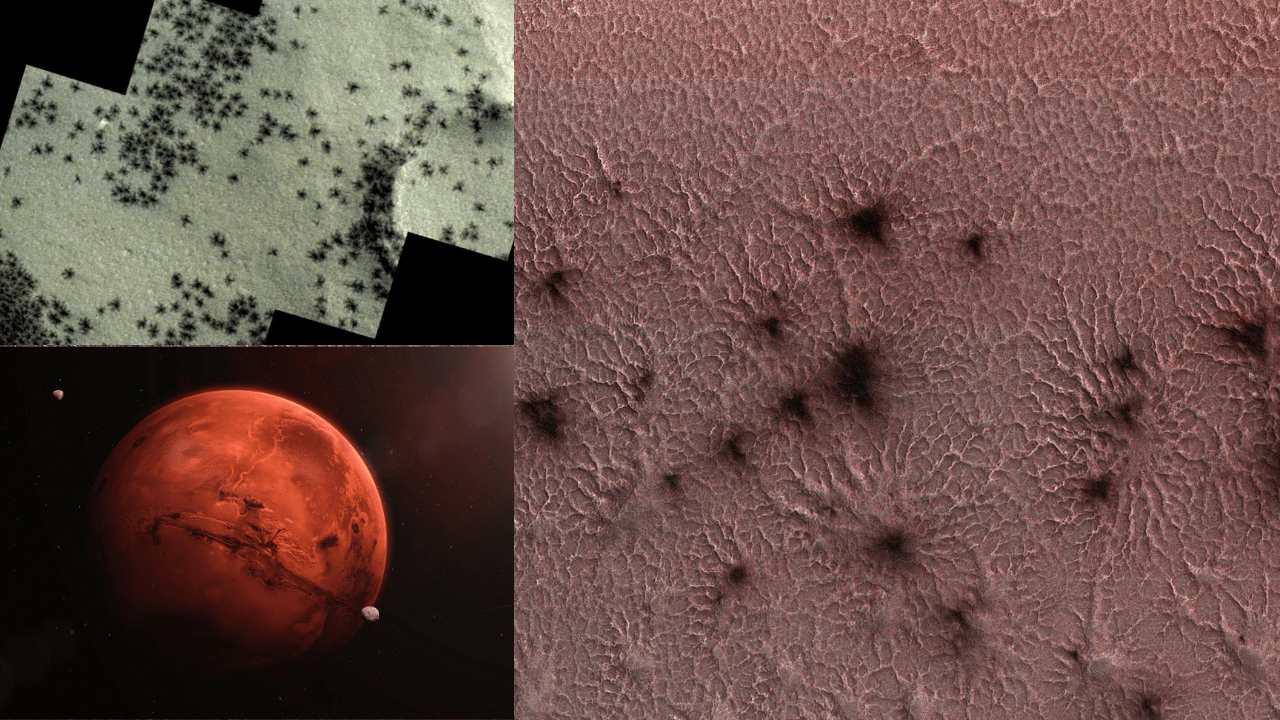Spiders on Mars Unveiled as Experts Explain Truth Behind Bizarre Photos Captured by Spacecraft, Stirring Global Fascination and Speculation.

A captivating image released by the European Space Agency (ESA) has ignited speculation about the existence of spiders on Mars. Captured by the ESA Mars Express spacecraft near the Inca City formation, these peculiar “spiders” have garnered attention and sparked curiosity about their origins.
Contrary to their arachnid appearance, these formations are not creatures but rather intricate patterns etched onto the Martian surface. According to ESA, they are the result of a fascinating natural phenomenon triggered by sunlight interacting with carbon dioxide deposits during the planet’s winter months.
As sunlight bathes the surface, it prompts the carbon dioxide ice beneath the deposits to transition into gas. This process creates pressure, causing the gas to burst through the thick ice, resulting in geysers of dust that settle on the surface, forming the distinctive spider-like patterns.
Although these formations may appear minuscule from space, they are, in fact, quite substantial. The ESA revealed that the largest patches can span up to 145 feet and may extend over half a mile wide. Beneath the surface, the intricate patterns are carved beneath layers of carbon dioxide ice, adding to their enigmatic allure.
Experts Unravel Mystery Behind Bizarre Photos Captured by Spacecraft, Igniting Global Intrigue and Speculation about SPIDERS on Mars
Interestingly, similar spider patterns were observed in 2020 by the ExoMars Trace Gas Orbiter, which has been diligently studying Mars for signs of past life since its launch in 2016. The majority of these dark spots are situated near the outskirts of the area known as “Inca City,” also referred to as Angustus Labyrinthus, near Mars’ south polar cap.
The formation of this area remains a puzzle, with various theories proposed to explain its origin. Some speculate that it could be the result of sand dunes gradually solidifying over time, while others suggest the possibility of magma or sand seeping through rock formations.
Meanwhile, the Mars Express orbiter has been a stalwart presence at the Red Planet since its arrival in late 2003. Over the past two decades, it has embarked on a remarkable journey, unraveling the mysteries of Mars’ atmosphere, tracing the history of water on its surface, and providing unprecedented insights into its two small moons. The orbiter’s accomplishments extend beyond scientific discovery, offering breathtaking views of the Martian landscape in stunning three-dimensional detail. Its unwavering dedication to exploration has paved the way for groundbreaking research and furthered our understanding of the Red Planet.
As we continue to unravel the mysteries of Mars, the discovery of these spider-like patterns serves as a reminder of the planet’s complex and dynamic nature. Each new revelation brings us closer to unlocking the secrets of this enigmatic world and deepening our connection to the cosmos.
In the vast expanse of space, Mars stands as a tantalizing frontier, beckoning us to explore its mysteries and unlock the secrets of our neighboring planet. With each discovery, we inch closer to uncovering the truth behind these otherworldly phenomena and expanding our horizons beyond the confines of Earth.
Also Read:

The Psychology of Love: Why Valentines Day Matters More Epic Than You Think
Discover the psychology of love and why Valentines Day is more important than you think. Learn how love impacts the brain, strengthens relationships, and boosts

Premier League Highlights: Arsenal Humiliate Man City 5-1, Spurs and Palace Secure Crucial Wins
Arsenal demolished Manchester City 5-1 in a statement premier league highlights win, reigniting their title hopes. Meanwhile, Crystal Palace stunned Man United 2-0, and Tottenham

How Budget 2025 Impacts the Indian Middle-Class: Major Tax Benefits and Glaring Omissions
Budget 2025 offers major tax relief to the middle class, including zero tax on incomes up to ₹12 lakh. However, it misses out on incentives

Degrees vs Employability: Why “Highly Qualified Degree Holders” Struggle to Find Jobs While “Less Qualified Individuals” Get Hired Faster!
Many highly qualified individuals struggle to secure jobs, while less qualified candidates get hired quickly. This Degrees vs Employability paradox is caused by employer preferences,

The Power of Mindset: Why Looking Poor Doesn’t Make You Poor, but Thinking Poor Does!
Discover why looking poor doesn’t define your wealth but thinking poor does. Learn the power of mindset and how a growth-oriented mindset can lead to

Overthinking: How It’s Damaging Today’s Youth – Causes and Cure in 2025
Understanding how overthinking is silently damaging today’s youth, from its causes rooted in societal pressure and social media to its long-term effects on mental health.
